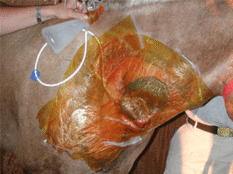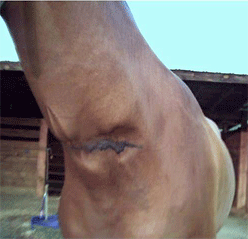Walnut Cove, North Carolina Call us: (336) 593-5422
Latitude 36 Mobile Veterinary Services
E-mail: lat36vet@aol.com
(copy & paste this address into your mail program)
Advanced Wound Care
Vacuum-Assisted Closure (VAC)
Dr. Gemeinhardt is one of the first veterinarians to have used vacuum-assisted closure (VAC) for the treatment of wounds in animals. In fact, she published the first-ever veterinary article on the use of vacuum-assisted closure in the horse* and has since instructed veterinarians in other states and countries on how to use the VAC system.
After publishing that first case, which involved two large neck wounds in a horse, Dr. Gemeinhardt has used the VAC system to accelerate wound healing and prevent/treat wound infection in horses and goats.
The VAC system may be used on wounds caused by traumatic injury and also after surgery when the surgical sitecannot be fully closed with sutures or staples. Burns and other severe skin and hoof defects are further uses for the VAC.
Currently, the patient must be hospitalized while the VAC system is being used. However, recent advances in VAC systems allow more patient mobility and at-home use in animals.
* Gemeinhardt, K. D., Molnar, J.A. Vacuum-assisted closure for management of a traumatic neck wound in a horse. Equine Veteterinary Education (EVE), 2005; 17 (1): 27-33.
Equine Amnion
Dr. Gemeinhardt also uses equine amnion for wound care. Amnion ("am-nee-on")
is the thin, fluid-filled sac that surrounds the unborn foal and is expelled with the placenta (afterbirth) when the foal is born. As a wound dressing - after proper preparation - amnion has some remarkable properties that speed wound healing.
For more information on either of these advanced wound care procedures, please contact Dr. Gemeinhardt.
The VAC system being used
on a neck wound in a horse.
The yellow plastic covering the wound and attached to the surrounding skin forms a complete seal over the wound. A vacuum pump applies continuous suction to the wound, which helps prevent infection and speeds wound closure, for a better functional and cosmetic result.
The case described in the EVE article, after treatment. The wound on the left side began as a crater 8" x 7" and 3" deep, exposing the jugular vein, esophagus, and trachea (windpipe).





